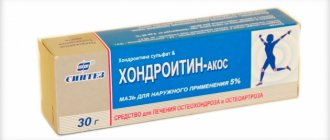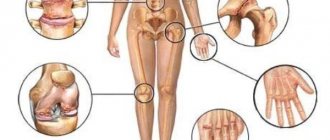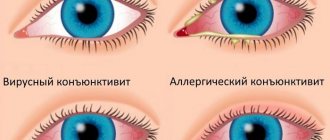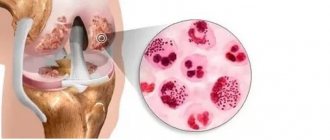Rheumatology
(from
rheumatism
) [1] - specialization of internal medicine, deals with the diagnosis and treatment of rheumatic diseases.
The term “rheumatology” itself comes from the Greek. ρεύμα, meaning "stream, river", and logos
, meaning "study".
The subject of study of rheumatology is inflammatory and degenerative-dystrophic diseases of the joints and systemic diseases of connective tissue (the outdated name is collagenosis). At the other pole of the differential diagnosis of rheumatology diseases is traumatology-orthopedics and purulent-septic surgery (osteomyelitis, myositis, gonorrheal arthritis, aseptic arthritis).
Rheumatology also works closely with:
- endocrinology (Charcot syndrome in diabetes mellitus, hypercalcemic crisis),
- nephrology (nephrogenic gout, nephrogenic osteomalacia, nephrogenic osteoporosis),
- hematology (in these matters, cross-differential diagnosis is the most difficult and often requires additional tests and studies, since many blood diseases can give, for example, acute lymphoblastic leukemia, a clinical picture of juvenile rheumatoid arthritis),
- cardiology (rheumatic endocarditis),
- vascular and phlebological surgery,
- sports medicine (damage to muscles and the musculoskeletal system in athletes).
indirectly with other system specializations:
- with infectology (in both cases, infection directly (rheumatoid arthritis, myositis, arthrosis) or indirectly (neuroborreliosis, Lyme disease, brucellosis, Mediterranean fever, trichinosis, tuberculosis, dysentery, streptococcal) requires high qualifications and training of specialists),
- toxicology (toxic arthropathy, myopathy, osteopathy, myalgia, arthralgia, poisoning with phosphorus and organophosphorus compounds),
- immunology (in a detailed study of immune complexes of systemic collagenoses),
- oncology, radiobiology and biophysics (on etiopathogenic risk factors for systemic autoimmune connective tissue diseases, in this case we are usually talking about chronic or one-time contacts with ionizing radiation in small doses that do not lead to severe surgical complications) and non-ionizing (quartz, ultraviolet, cold exposure , which draws a clear line between an etipathogenic risk factor and traumatology, where the impact is determined by the nature of the force, is usually one-time impact in nature and is determined by the nature of the force (burns, thermal shock or frostbite, radiation injury, electric shock),
- spinal neurology (osteochondrosis, torticollis, scoliosis),
- and neurosurgery.
What is rheumatology
Rheumatology
is a branch of medicine that deals with the study, diagnosis and treatment of rheumatic diseases. The most common of these are rheumatic fever and acquired heart defects, diffuse connective tissue diseases (DCT) (systemic lupus erythematosus, systemic scleroderma, inflammatory myopathies) and arthritis (for example, rheumatoid, reactive, psoriatic), gout, ankylosing spondylitis, diseases blood vessels (vasculitis), osteoporosis, osteoarthritis.
For the most part, all rheumatological diseases are united by the presence of inflammation and impaired immune processes. Rheumatology is divided into pediatric and adult
, because In childhood, rheumatological diseases have their own characteristics of onset, course and treatment.
When examining a patient with suspected rheumatological disease, it is often necessary to resort to consultation with other specialists, because The rheumatological sphere constantly merges with different areas of medicine, where similar syndromes can occur (cardiology, phthisiology, oncology, infection, hematology, etc.). The insidiousness of rheumatic pathology lies in the fact that the disease does not always manifest itself with a characteristic set of symptoms and syndromes, and in most cases it is disguised as others. Therefore, rheumatology patients need to stock up on great patience, punctuality and discipline when following the recommendations and prescriptions of the rheumatologist, because the choice of medications will depend on the accuracy of the diagnosis (I will discuss them in more detail in the next post).
Definition of the word “Rheumatology” according to TSB:
Rheumatology (from Rheumatism and ... logia (See ... Logia)) is a section of internal medicine (see Therapy), studying rheumatic diseases: systemic connective tissue diseases (rheumatism, systemic Lupus erythematosus, systemic Scleroderma, Dermatomyositis and Periarteritis Nodosa), Arthritis (rheumatoid etc.), osteoarthritis and lesions of extra-articular tissues (periarthritis, fibrositis, tendovaginitis, bursitis, etc.). R.'s problems are studied comprehensively: by clinicians, morphologists, immunologists, biochemists, physiologists, radiologists, and others. R. is closely related to nephrology, cardiology, hematology, pulmonology, and other sections of internal medicine and clinical disciplines, since systemic connective tissue diseases can occur in forms of predominantly renal, cardiac, cerebral and other syndromes, and some syndromes studied by R. are associated with blood diseases, tumors and other pathological processes. Rheumatic inflammation of the joints was described by Hippocrates. K. Galen in the 2nd century. introduced the term “rheumatism” to refer to various diseases of the musculoskeletal system, and this generalized concept existed until the 19th century. However, already in the 17-18 centuries. descriptions of individual rheumatic diseases appeared. Thus, T. Sydenham identified rheumatic arthritis and chorea, the English doctor W. Heberden described (1802) nodules on the fingers, characteristic of Arthrosis, distinguishing it from gout. In the 30s 19th century The founders of the modern doctrine of rheumatism, the French doctor J. B. Buyot and G. I. Sokolsky, independently of each other, established a connection between polyarthritis and heart damage. In subsequent years, rheumatoid arthritis was isolated from the general group of rheumatism (American doctor A. B. Gerrod and J. M. Charcot), systemic lupus erythematosus (Hungarian - M. K. Kaposi), scleroderma (French - E. Gintrak), etc. Formation of the idea of the existence of connective tissue itself with its characteristic reactions (M. F. Bisha, 1801), description of the pathomorphological picture of a number of rheumatic diseases (R. Virchow, K. Rokitansky, etc.) and fibrinoid changes characteristic of the pathology of connective tissue (German pathologist E. Neumann, 1880) became an important theoretical basis for the development of R. in the 19th century. S.P. Botkin was the first to note the connection between rheumatism and infection and described rheumatic pleurisy, nephritis (1874-85), thereby emphasizing the systemic nature of the disease. G. A. Zakharyin proved its nosological independence and the effectiveness of its treatment with salicylates (1899). G. M. Malkov noted the role of streptococcus and inflammation of the pharyngeal tonsils in the development of rheumatism (1900). I. A. Chistyakov identified 3 forms of scleroderma - limited, diffuse and mixed (1886). In the 20th century The streptococcal concept of the etiology of rheumatism was established (American scientist A.F. Coburn, N.D. Strazhesko, G.F. Lang, etc.). A. A. Bogomolets put forward the doctrine of connective tissue as a physiological system that performs, in particular, protective functions (1926). Based on the studies of V. T. Talalaev (1929), who showed the staged nature of morphological changes in the connective tissue of the heart, and the experimental works of the German scientist F. Klinge (1933), the theory of the allergic genesis of rheumatism and rheumatic diseases was formulated, developed in the USSR by N. D. Strazhesko and M.P. Konchalovsky formulated the doctrine of collagen diseases (American scientist P. Klemperer et al., 1942) and the role of immune disorders in their genesis. A.D. Speransky, with his doctrine of the neurotrophic mechanism of the pathological process (1935), drew attention to the role of the nervous system in the pathogenesis and sanogenesis of various diseases, including rheumatism. A. A. Kisel formulated the criteria for diagnosing rheumatism in children. American rheumatologist F. S. Hench introduced (1950) corticosteroids into the treatment of rheumatic diseases. Development of R. in the 2nd half of the 20th century. was marked by the successful use of immunological and biochemical methods, which made it possible to improve diagnosis and understand the mechanisms of the staged development of rheumatic diseases. biopsies of synovial membranes, kidneys, skin, etc., facilitating intravital study of pathological changes in organs. radioisotope diagnostics of the system process. Virological research methods, the study of nucleic acid metabolism, disorders of humoral and cellular immunity and immunogenetic abnormalities are used. Methods of immunosuppressive treatment (corticosteroids, cytostatics) in combination with the principle of phasing (hospital - clinic), ensuring long-term use of these drugs, have improved the prognosis for many rheumatic diseases. These achievements are associated with the names of M. Ziff, L. Shulman, J. Decker and others in the USA. E. J. Bywaters, A. Dixon, L. E. Glynn in Great Britain. F. Delbar and S. de Seza in France. N. Swartz and B. Olgahena in Sweden. V. Laine in Finland. S. Sitya and A. Shust in Czechoslovakia. V. Tsoncheva and T. Pilosof in the NRB. K. Seidel and W. Otto in the GDR: J. Pangovskaya-Wavrzynska in the People's Republic of Poland. I. Stoya in the SRR, Z. Berovich in the SFRY, etc. In the USSR, the works of A. I. Nesterov, E. M. Tareev, and A. I. Strukov, devoted to the study of rheumatic diseases, were awarded the Lenin Prize in 1974. R.’s successes contributed to its recognition in the 60s. 20th century into an independent section of internal medicine. In many countries, specialized research institutes on the problems of rheumatism have been organized (for example, the Institute of Rheumatism of the USSR Academy of Medical Sciences in Moscow, the Institute of Rheumatic Diseases in Prague, institutes of rheumatism in Warsaw and Belgrade, the Institute of Rheumatism in London, etc.). In the USSR, the network of cardio-rheumatological institutions covers (1974) almost 3 thousand offices in clinics, 128 centers and 11 large dispensaries. The training of rheumatologists is carried out mainly at the Institute of Rheumatism and during rheumatism cycles at institutes for advanced training of doctors. The All-Union Antirheumatic Committee was organized in 1928 by M. P. Konchalovsky and G. M. Danishevsky. in 1964 it was transformed into the All-Union Society of Rheumatologists. Since 1928 it has been a member of the International League Against Rheumatism (founded in 1928). International congresses of rheumatologists (since 1926) are held every 4 years. The 13th Congress took place in Kyoto in 1973. The journal Rheumatology (Basel, since 1967) is the organ of the International League. The journal “Questions of Rheumatism” has been published in the USSR since 1961 (the first separate issues were in 1934). Lit.: Velyaminov N. A., The doctrine of joint diseases from a clinical point of view, L., 1924. Bogomolets A. A., Introduction to the doctrine of constitutions and diathesis, M., 1926. Strukov A. I., Beglaryan A. G., Pathological anatomy and pathogenesis of collagen diseases, M., 1963. Tareev E. M., Collagenoses, M., 1965. Nesterov A. I., Sigidin Ya. A., Clinic of collagen diseases, 2nd ed., M. ., 1966. Astapenko M. G., Pikhlak E. G., Diseases of the joints, M., 1966. Gritsman N. N., Heart damage in collagen diseases, M., 1971. see also lit. at Art. Rheumatism. V. A. Nasonova.
Risk group for rheumatic diseases
Rheumatological pathology can debut in any age group, but there are a number of diseases that are more common in older age (after 45-50 years), for example, polymyalgia rheumatica, osteoarthritis and osteoporosis, although there are cases of occurrence in young people, but very rarely.
Rheumatic diseases have “preferences” based on gender differences. Thus, gout, ankylosing spondylitis (ankylosing spondylitis), and psoriatic arthritis occur, as a rule, in men. And rheumatoid arthritis, CTD, polymyalgia rheumatica, vasculitis are more common in women.
Rheumatology. The most common joint diseases
Gout is a disease in the field of rheumatology, which is an increased level of uric acid in the blood and urine, the salts of which are deposited in the joints and kidneys. Gout has the following symptoms: the occurrence of acute pain in the joint of the phalanx of the first toe, its swelling and deformation, movements in the joint become impossible, body temperature rises, and subcutaneous formations - tophi - appear.
Rheumatology advises patients to follow a diet with minimal protein, eliminate alcohol from their diet and reduce physical stress on the body and joints in particular. Arthritis is an inflammatory process of both internal organs and joints. Rheumatology identifies the following causes of the disease: acute pain in the joints, difficulty in their movement, external deformation of the joint itself and the manifestation of rheumatoid nodules under the skin.
Modern rheumatology still cannot establish the exact causes of arthritis, but the most common theory is a hereditary predisposition to the disease. Hormonal imbalance can also be a possible cause of arthritis.
Treatment of arthritis occurs with the help of medications and is prescribed individually by a rheumatologist.
Osteochondrosis is a disease that affects the spine and is caused by degenerative changes in the disc (its drying out). The main signs of osteochondrosis:
- The appearance of pain in the heart;
- Increasing pain that occurs in the back, legs;
- Fatigue at the slightest physical exertion;
- Numbness of the limbs;
- The appearance of dizziness and pain in the head.
Doctors from rheumatology departments in Moscow approach the treatment of osteochondrosis individually, only after establishing the causes of the disease. Rheumatology considers the main task to be the reduction or disappearance of symptoms, as well as the restoration of mobility to the spine.
Ankylosing spondylitis is a chronic disease that causes damage to the joints, especially the spine, as well as internal organs. The reason is predisposed heredity. Symptoms of ankylosing spondylitis are: increasing pain in the spine and other joints, limited mobility in the spine, over time its deformation forms, and the disease gradually affects other internal organs. Treatment is prescribed on an individual basis, depending on the activity of the disease, the degree of damage and timely contact with a doctor.
Why do rheumatic diseases occur?
To date, the answer to this question is known for few diseases. Thus, the cause for the development of rheumatic fever is betahemolytic streptococcus A. Acquired heart defects are the consequences of either inadequately treated tonsillitis, rheumatic fever, a chronic infectious focus in the body, or an infection suffered on the legs that showed little effect. After all, how often do we not pay due attention to our well-being and, for example, go to work feeling unwell, or even with a sore throat, or put off a visit to the dentist with a long-term toothache, and teeth that are not treated in a timely manner under certain conditions are also a source of infection.
Osteoarthritis (osteoarthritis in Western terminology).
This is a disease related to degenerative diseases of the musculoskeletal system. It occurs predominantly after 50-55 years in women, in men after 55-60 years, and by the age of 70 it affects both sexes almost equally. The cause is thought to be “wear and tear” of the cartilage lining the surface of the joint.
Causes and symptoms of rheumatic diseases
One of the most important tasks of a rheumatologist is to determine the nature of the disease. Most rheumatic diseases are caused by heredity: the predisposition is transmitted genetically, but the disease develops only under the influence of environmental factors or unfavorable internal causes.
Factors provoking rheumatic diseases:
- past infectious diseases,
- hypothermia or, conversely, excessive exposure to the sun;
- intoxication,
- severe stress;
- hormonal imbalances.
Under the influence of negative factors in the body, the immunological balance can be disturbed, as a result of which autoimmune inflammatory processes develop. They manifest themselves in the form of pain, spasms and even loss of motor activity.
When should you see a rheumatologist?
In this regard, there are clear recommendations from the American Rheumatological Association, which all doctors should use in their actions. However, for various reasons, the patient may lose an indefinite amount of time before reaching a rheumatologist. During this time, the clinical picture may become distorted, characteristic laboratory parameters may change, which will lead to untimely diagnosis and late treatment. So, if for at least 1-2 weeks:
– joint pain persists, – there is stiffness in the morning and it takes at least 30 minutes to “stretch” the joints for more comfortable movement, – a feeling of stiffness in the back, especially in the lumbosacral region in men, – an elevated body temperature persists, – there is deformation of the joints due to bone changes, swelling or swelling in the joint area, - the joint is warmer to the touch than the surrounding tissues to the point of being hot, - pain, aching muscles, weakness in the limbs, - nodular formations from pink to purple-bluish on the skin, - recently, at least 1 month, acute intestinal infection, urogenital infection, - redness of the cheeks and forehead, without a tendency to decrease, - areas of skin thickening, with impaired sensitivity, changes in appearance, - decreased height and bone fractures, - the appearance of stretch marks , stretch marks on the skin without previous weight loss or pregnancy, - acute headaches with clear localization, especially in combination with low-grade fever or heavy sweating, or weakness, - the above symptoms in various combinations, or arising after provoking factors, - obstetric pathology in the form of miscarriage , spontaneous abortions - among blood relatives the presence of rheumatic disease and the appearance of similar symptoms, THEN SHOULD BE SUSPECTED OF
A POSSIBLE MANIFESTATION
of rheumatological disease and consult a rheumatologist for examination.
In what cases should you consult a doctor?
You should not delay making an appointment with a rheumatologist if symptoms of rheumatological diseases appear, especially if they persist for a long time.
Symptoms for which it is recommended to consult a rheumatologist:
- joints hurt and/or become swollen;
- bones, muscles, back, spine hurt;
- there are cases of rheumatic diseases in the family;
- there are risk factors for osteoporosis: there were cases of hip fractures and low-traumatic fractures in the family; you have chronic kidney, liver, stomach, blood disease, low weight or obesity; you have early menopause (spontaneous or surgical) before the age of 45;
- if you are intolerant or do not consume dairy products;
- if you are taking or administering prednisolone, metypred, dexamethasone, polcortolone, diprospan, kenalog and other glucocorticosteroids;
- if you are taking anticonvulsants, anticoagulants (warfarin, phenylin, heparin, low molecular weight heparins), antacids (Maalox, Almagel), thyroid hormones (levothyroxine, euthyrox);
- you have recurrent iridocyclitis, uveitis, episcleritis;
- you are allergic to the sun (photodermatitis);
- you have been diagnosed with Raynaud's syndrome;
- you have a prolonged low-grade fever or fever;
- you have been experiencing accelerated ESR for a long time.
It is not recommended to ignore symptoms that persist for several days, much less weeks. The sooner you contact a rheumatologist, the more effective the therapy prescribed by your doctor will be.
How to avoid becoming a patient at a rheumatology office?
I think these recommendations should be taken into account by everyone. The vast majority of people know little about their ancestry by disease; at best, knowledge stops with grandparents. What did the ancestors of older generations suffer from? Great-grandparents? After all, previously there were no diagnostic capabilities or accumulated clinical data that we have now. It’s good if patients remember and describe some characteristic features suitable for a particular disease, sometimes this helps to suspect pathology. And we carry genetic information within us for many hundreds, thousands of generations of our ancestors, and in whom at what moment and how exactly “the gene will make its way into a trait,” i.e. will manifest itself as a disease, no one knows for sure. Therefore, be attentive and respectful to the health you have, so as not to miss the onset of pathology, diagnose it in a timely manner, begin treatment and maintain your usual quality of life.
The following notes will discuss methods of diagnosis and treatment of rheumatic diseases.
The author of the article is physician-therapist Potapova
M.V.










